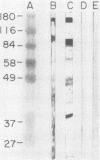Abstract
Attachment of bacteria to phagocytic cells may be mediated by lectin-carbohydrate interactions, resulting in lectinophagocytosis. The best-studied system is the interaction of type 1-fimbriated (mannose-specific) Escherichia coli with human phagocytic cells. Here we demonstrate that the leukocyte integrins CD11 and CD18 (CD11/CD18) constitute the major receptors for type 1-fimbriated E. coli. Bacteria were bound in a dose-dependent and saturable manner to CD11/CD18, which was immobilized to microwells, whereas nonfimbriated E. coli cells failed to bind. The binding was efficiently inhibited (82 to 85%) by methyl-alpha-mannoside but not by galactose, and it was reduced by treatment of the immobilized CD11/CD18 with sodium metaperiodate, endoglycosidase H, or a mixture of endoglycosidase F and N-glycosidase. The fimbriated bacteria also bound to CD11a,b,c and CD18 separated by polyacrylamide gel electrophoresis with sodium dodecyl sulfate and blotted onto nitrocellulose paper. This binding was inhibited specifically by methyl-alpha-mannoside and was significantly diminished by treatment of the blots with sodium metaperiodate. Only minimal binding to the blotted CD11/CD18 that had been deglycosylated enzymatically prior to electrophoresis was observed. On blots of granulocyte lysates, specific binding to two glycoproteins (Mrs, 90,000 to 100,000 and 165,000) with mobilities similar to that of CD11/CD18 was observed. Monoclonal antibodies to CD11a, CD11b, or CD18 inhibited the binding of the bacteria to intact human granulocytes by 55 to 80%, whereas antibodies against other leukocyte surface antigens were not inhibitory. We conclude that type 1-fimbriated E. coli binds to human granulocytes via the oligomannose and hybrid N-linked units of CD11/CD18. Since CD11b/CD18 and CD11c/CD18 are known to serve as receptors for complement fragment iC3b, this study provides a link between opsonophagocytosis and lectinophagocytosis.
Full text
PDF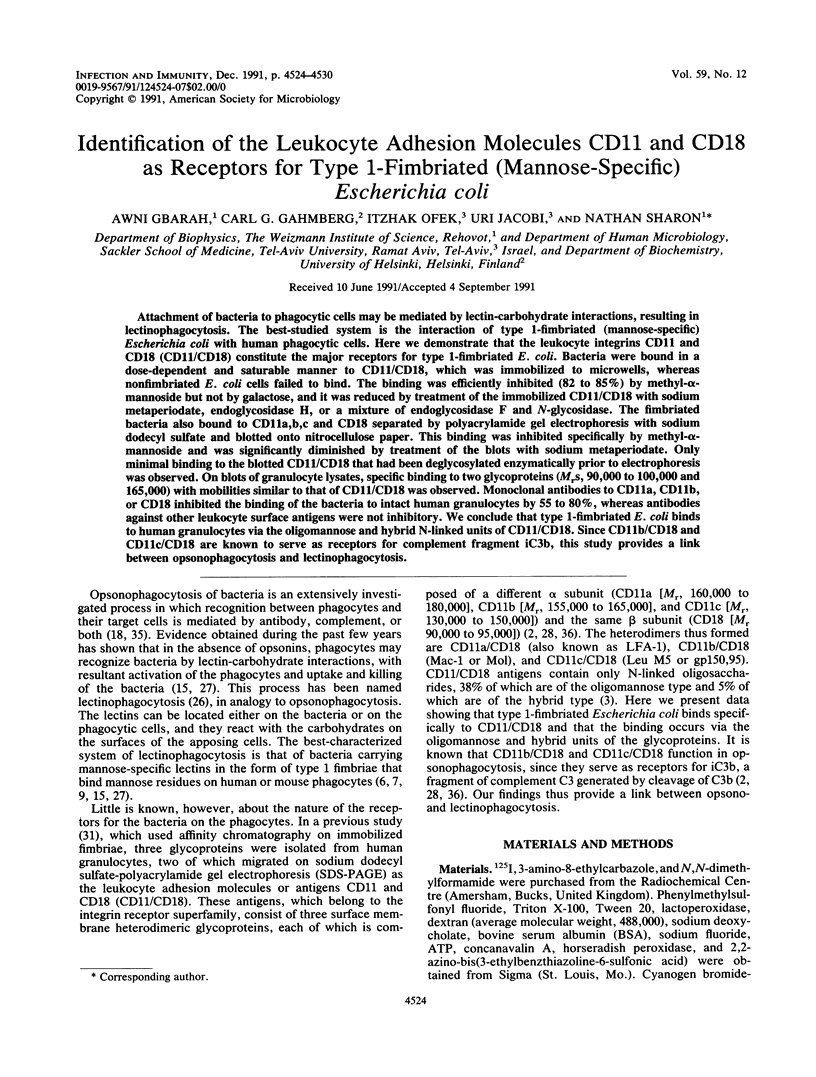
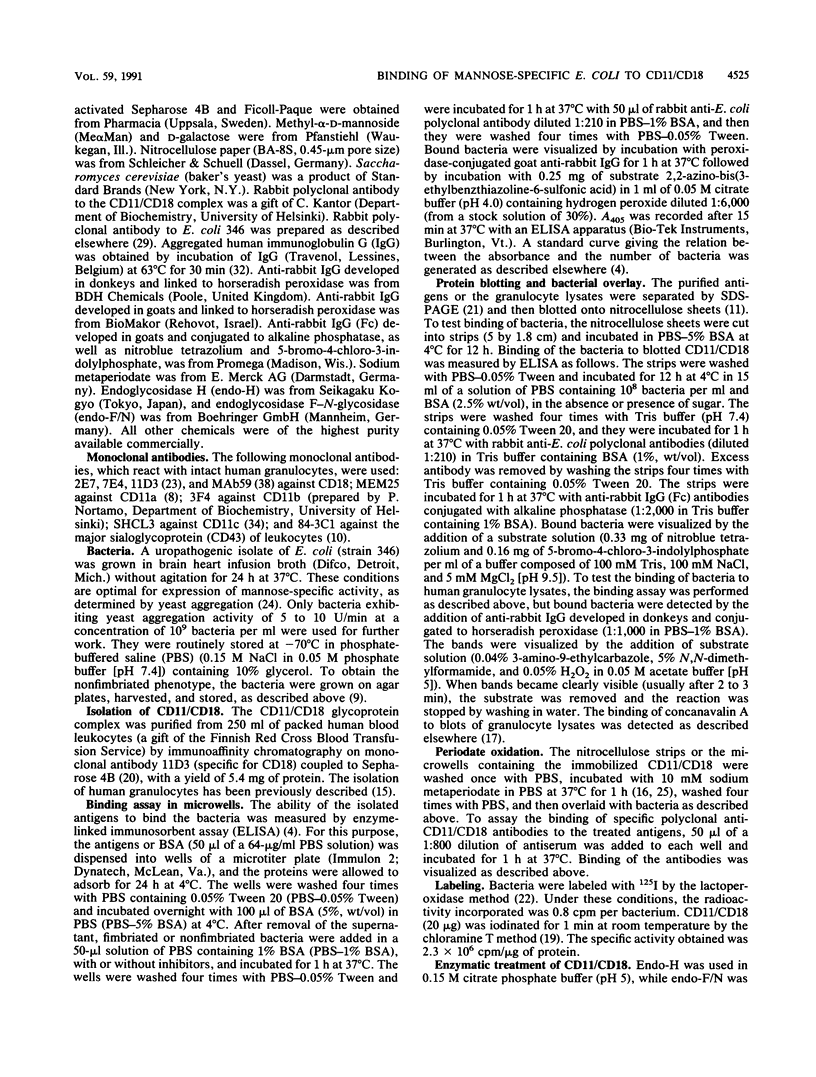
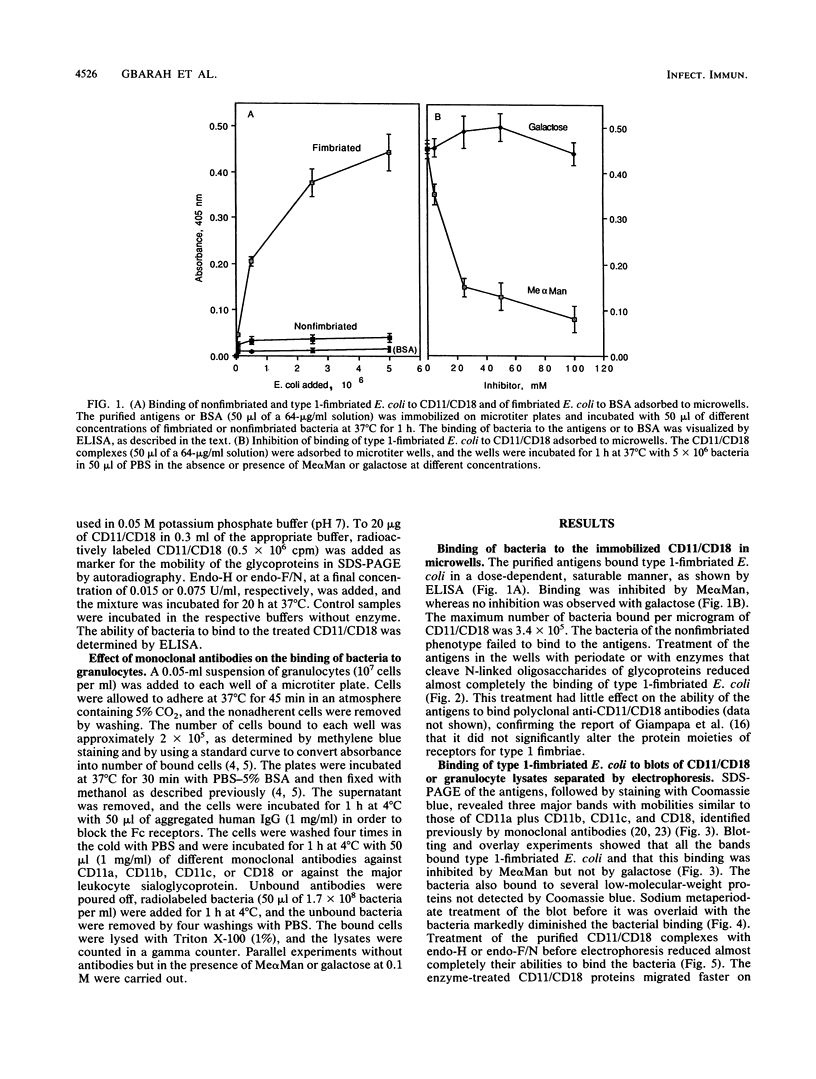
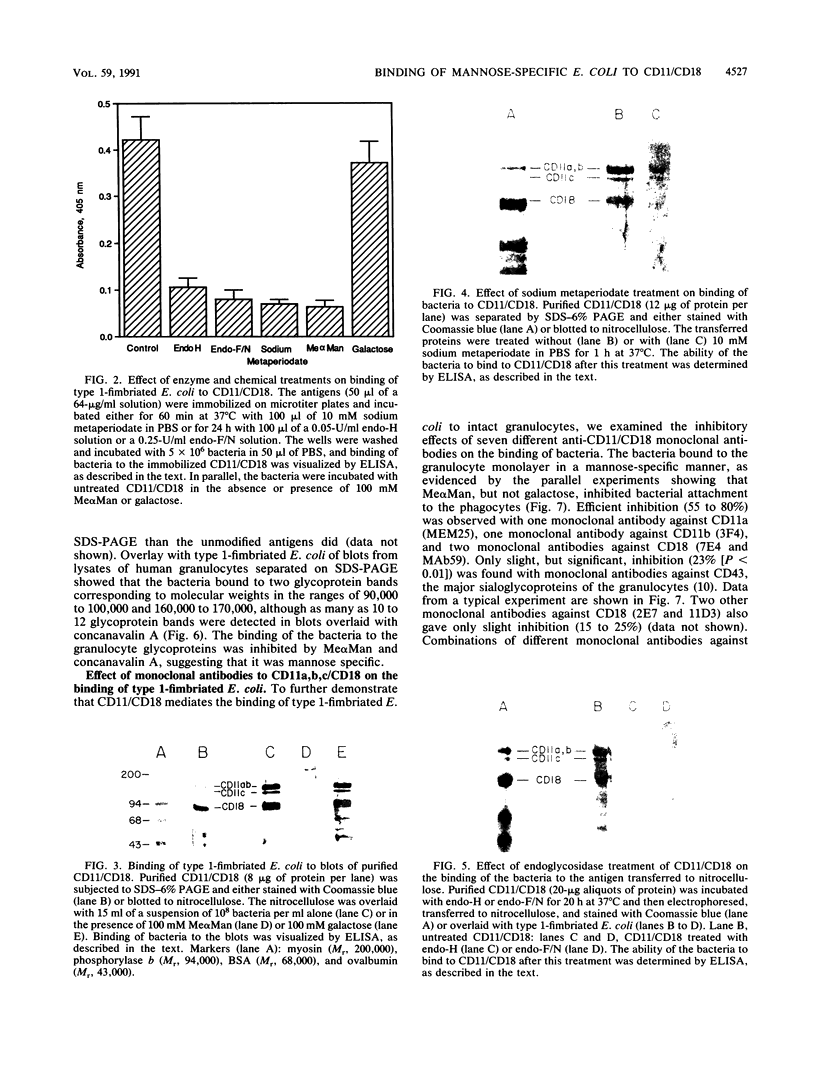
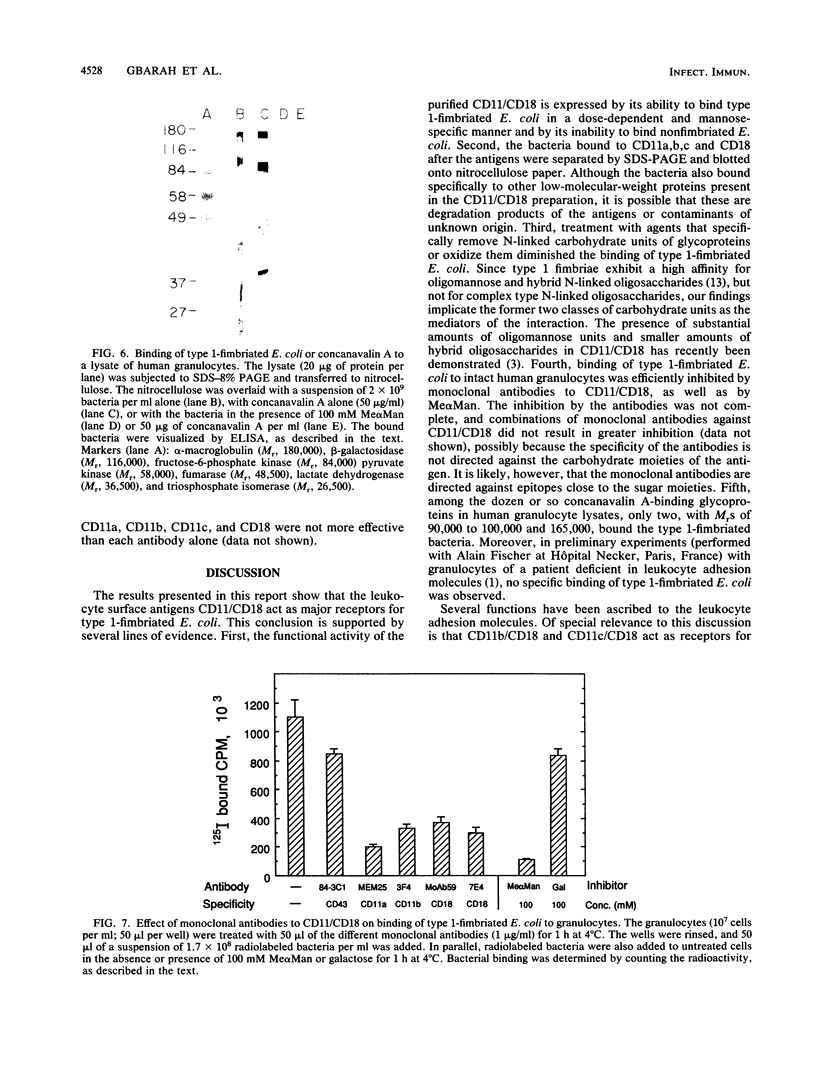
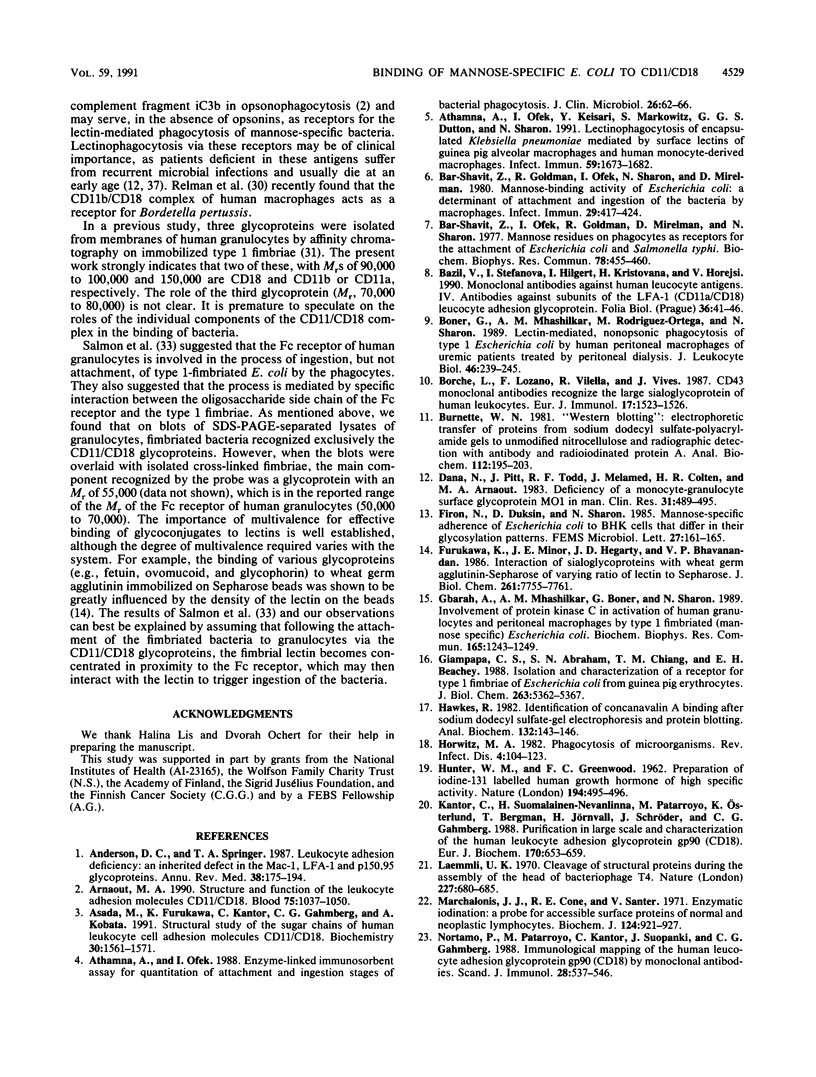
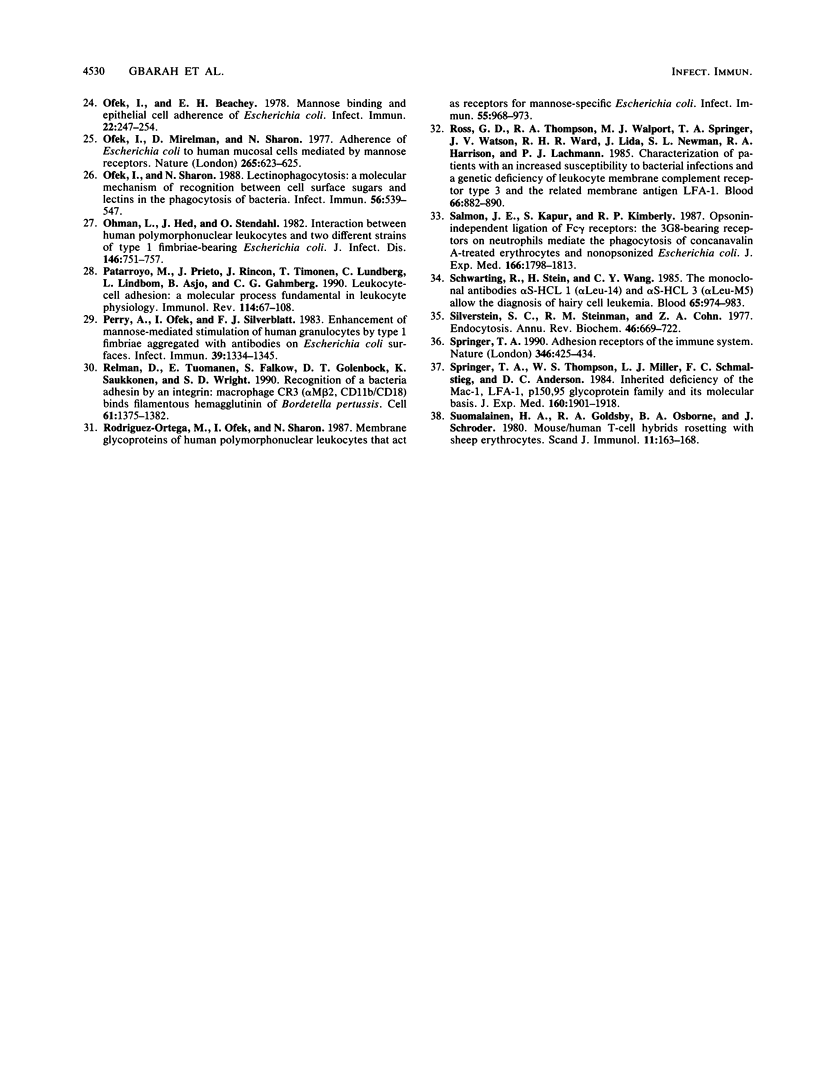
Images in this article
Selected References
These references are in PubMed. This may not be the complete list of references from this article.
- Anderson D. C., Springer T. A. Leukocyte adhesion deficiency: an inherited defect in the Mac-1, LFA-1, and p150,95 glycoproteins. Annu Rev Med. 1987;38:175–194. doi: 10.1146/annurev.me.38.020187.001135. [DOI] [PubMed] [Google Scholar]
- Arnaout M. A. Structure and function of the leukocyte adhesion molecules CD11/CD18. Blood. 1990 Mar 1;75(5):1037–1050. [PubMed] [Google Scholar]
- Asada M., Furukawa K., Kantor C., Gahmberg C. G., Kobata A. Structural study of the sugar chains of human leukocyte cell adhesion molecules CD11/CD18. Biochemistry. 1991 Feb 12;30(6):1561–1571. doi: 10.1021/bi00220a017. [DOI] [PubMed] [Google Scholar]
- Athamna A., Ofek I. Enzyme-linked immunosorbent assay for quantitation of attachment and ingestion stages of bacterial phagocytosis. J Clin Microbiol. 1988 Jan;26(1):62–66. doi: 10.1128/jcm.26.1.62-66.1988. [DOI] [PMC free article] [PubMed] [Google Scholar]
- Athamna A., Ofek I., Keisari Y., Markowitz S., Dutton G. G., Sharon N. Lectinophagocytosis of encapsulated Klebsiella pneumoniae mediated by surface lectins of guinea pig alveolar macrophages and human monocyte-derived macrophages. Infect Immun. 1991 May;59(5):1673–1682. doi: 10.1128/iai.59.5.1673-1682.1991. [DOI] [PMC free article] [PubMed] [Google Scholar]
- Bar-Shavit Z., Goldman R., Ofek I., Sharon N., Mirelman D. Mannose-binding activity of Escherichia coli: a determinant of attachment and ingestion of the bacteria by macrophages. Infect Immun. 1980 Aug;29(2):417–424. doi: 10.1128/iai.29.2.417-424.1980. [DOI] [PMC free article] [PubMed] [Google Scholar]
- Bar-Shavit Z., Ofek I., Goldman R., Mirelman D., Sharon N. Mannose residues on phagocytes as receptors for the attachment of Escherichia coli and Salmonella typhi. Biochem Biophys Res Commun. 1977 Sep 9;78(1):455–460. doi: 10.1016/0006-291x(77)91276-1. [DOI] [PubMed] [Google Scholar]
- Bazil V., Stefanová I., Hilgert I., Kristofová H., Vanek S., Horejsí V. Monoclonal antibodies against human leucocyte antigens. IV. Antibodies against subunits of the LFA-1 (CD11a/CD18) leucocyte-adhesion glycoprotein. Folia Biol (Praha) 1990;36(1):41–50. [PubMed] [Google Scholar]
- Boner G., Mhashilkar A. M., Rodriguez-Ortega M., Sharon N. Lectin-mediated, nonopsonic phagocytosis of type 1 Escherichia coli by human peritoneal macrophages of uremic patients treated by peritoneal dialysis. J Leukoc Biol. 1989 Sep;46(3):239–245. doi: 10.1002/jlb.46.3.239. [DOI] [PubMed] [Google Scholar]
- Borche L., Lozano F., Vilella R., Vives J. CD43 monoclonal antibodies recognize the large sialoglycoprotein of human leukocytes. Eur J Immunol. 1987 Oct;17(10):1523–1526. doi: 10.1002/eji.1830171023. [DOI] [PubMed] [Google Scholar]
- Burnette W. N. "Western blotting": electrophoretic transfer of proteins from sodium dodecyl sulfate--polyacrylamide gels to unmodified nitrocellulose and radiographic detection with antibody and radioiodinated protein A. Anal Biochem. 1981 Apr;112(2):195–203. doi: 10.1016/0003-2697(81)90281-5. [DOI] [PubMed] [Google Scholar]
- Furukawa K., Minor J. E., Hegarty J. D., Bhavanandan V. P. Interaction of sialoglycoproteins with wheat germ agglutinin-sepharose of varying ratio of lectin to Sepharose. Use for the purification of mucin glycoproteins from membrane extracts. J Biol Chem. 1986 Jun 15;261(17):7755–7761. [PubMed] [Google Scholar]
- Gbarah A., Mhashilkar A. M., Boner G., Sharon N. Involvement of protein kinase C in activation of human granulocytes and peritoneal macrophages by type 1 fimbriated (mannose specific) Escherichia coli. Biochem Biophys Res Commun. 1989 Dec 29;165(3):1243–1249. doi: 10.1016/0006-291x(89)92735-6. [DOI] [PubMed] [Google Scholar]
- Giampapa C. S., Abraham S. N., Chiang T. M., Beachey E. H. Isolation and characterization of a receptor for type 1 fimbriae of Escherichia coli from guinea pig erythrocytes. J Biol Chem. 1988 Apr 15;263(11):5362–5367. [PubMed] [Google Scholar]
- HUNTER W. M., GREENWOOD F. C. Preparation of iodine-131 labelled human growth hormone of high specific activity. Nature. 1962 May 5;194:495–496. doi: 10.1038/194495a0. [DOI] [PubMed] [Google Scholar]
- Hawkes R. Identification of concanavalin A-binding proteins after sodium dodecyl sulfate--gel electrophoresis and protein blotting. Anal Biochem. 1982 Jun;123(1):143–146. doi: 10.1016/0003-2697(82)90634-0. [DOI] [PubMed] [Google Scholar]
- Horwitz M. A. Phagocytosis of microorganisms. Rev Infect Dis. 1982 Jan-Feb;4(1):104–123. doi: 10.1093/clinids/4.1.104. [DOI] [PubMed] [Google Scholar]
- Kantor C., Suomalainen-Nevanlinna H., Patarroyo M., Osterlund K., Bergman T., Jörnvall H., Schröder J., Gahmberg C. G. Purification in large scale and characterization of the human leukocyte adhesion glycoprotein GP90 (CD18). Eur J Biochem. 1988 Jan 4;170(3):653–659. doi: 10.1111/j.1432-1033.1988.tb13747.x. [DOI] [PubMed] [Google Scholar]
- Laemmli U. K. Cleavage of structural proteins during the assembly of the head of bacteriophage T4. Nature. 1970 Aug 15;227(5259):680–685. doi: 10.1038/227680a0. [DOI] [PubMed] [Google Scholar]
- Marchalonis J. J., Cone R. E., Santer V. Enzymic iodination. A probe for accessible surface proteins of normal and neoplastic lymphocytes. Biochem J. 1971 Oct;124(5):921–927. doi: 10.1042/bj1240921. [DOI] [PMC free article] [PubMed] [Google Scholar]
- Nortamo P., Patarroyo M., Kantor C., Suopanki J., Gahmberg C. G. Immunological mapping of the human leucocyte adhesion glycoprotein gp90 (CD18) by monoclonal antibodies. Scand J Immunol. 1988 Nov;28(5):537–546. doi: 10.1111/j.1365-3083.1988.tb01485.x. [DOI] [PubMed] [Google Scholar]
- Ofek I., Beachey E. H. Mannose binding and epithelial cell adherence of Escherichia coli. Infect Immun. 1978 Oct;22(1):247–254. doi: 10.1128/iai.22.1.247-254.1978. [DOI] [PMC free article] [PubMed] [Google Scholar]
- Ofek I., Mirelman D., Sharon N. Adherence of Escherichia coli to human mucosal cells mediated by mannose receptors. Nature. 1977 Feb 17;265(5595):623–625. doi: 10.1038/265623a0. [DOI] [PubMed] [Google Scholar]
- Ofek I., Sharon N. Lectinophagocytosis: a molecular mechanism of recognition between cell surface sugars and lectins in the phagocytosis of bacteria. Infect Immun. 1988 Mar;56(3):539–547. doi: 10.1128/iai.56.3.539-547.1988. [DOI] [PMC free article] [PubMed] [Google Scholar]
- Ohman L., Hed J., Stendahl O. Interaction between human polymorphonuclear leukocytes and two different strains of type 1 fimbriae-bearing Escherichia coli. J Infect Dis. 1982 Dec;146(6):751–757. doi: 10.1093/infdis/146.6.751. [DOI] [PubMed] [Google Scholar]
- Patarroyo M., Prieto J., Rincon J., Timonen T., Lundberg C., Lindbom L., Asjö B., Gahmberg C. G. Leukocyte-cell adhesion: a molecular process fundamental in leukocyte physiology. Immunol Rev. 1990 Apr;114:67–108. doi: 10.1111/j.1600-065x.1990.tb00562.x. [DOI] [PubMed] [Google Scholar]
- Perry A., Ofek I., Silverblatt F. J. Enhancement of mannose-mediated stimulation of human granulocytes by type 1 fimbriae aggregated with antibodies on Escherichia coli surfaces. Infect Immun. 1983 Mar;39(3):1334–1345. doi: 10.1128/iai.39.3.1334-1345.1983. [DOI] [PMC free article] [PubMed] [Google Scholar]
- Relman D., Tuomanen E., Falkow S., Golenbock D. T., Saukkonen K., Wright S. D. Recognition of a bacterial adhesion by an integrin: macrophage CR3 (alpha M beta 2, CD11b/CD18) binds filamentous hemagglutinin of Bordetella pertussis. Cell. 1990 Jun 29;61(7):1375–1382. doi: 10.1016/0092-8674(90)90701-f. [DOI] [PubMed] [Google Scholar]
- Rodriguez-Ortega M., Ofek I., Sharon N. Membrane glycoproteins of human polymorphonuclear leukocytes that act as receptors for mannose-specific Escherichia coli. Infect Immun. 1987 Apr;55(4):968–973. doi: 10.1128/iai.55.4.968-973.1987. [DOI] [PMC free article] [PubMed] [Google Scholar]
- Ross G. D., Thompson R. A., Walport M. J., Springer T. A., Watson J. V., Ward R. H., Lida J., Newman S. L., Harrison R. A., Lachmann P. J. Characterization of patients with an increased susceptibility to bacterial infections and a genetic deficiency of leukocyte membrane complement receptor type 3 and the related membrane antigen LFA-1. Blood. 1985 Oct;66(4):882–890. [PubMed] [Google Scholar]
- Salmon J. E., Kapur S., Kimberly R. P. Opsonin-independent ligation of Fc gamma receptors. The 3G8-bearing receptors on neutrophils mediate the phagocytosis of concanavalin A-treated erythrocytes and nonopsonized Escherichia coli. J Exp Med. 1987 Dec 1;166(6):1798–1813. doi: 10.1084/jem.166.6.1798. [DOI] [PMC free article] [PubMed] [Google Scholar]
- Schwarting R., Stein H., Wang C. Y. The monoclonal antibodies alpha S-HCL 1 (alpha Leu-14) and alpha S-HCL 3 (alpha Leu-M5) allow the diagnosis of hairy cell leukemia. Blood. 1985 Apr;65(4):974–983. [PubMed] [Google Scholar]
- Silverstein S. C., Steinman R. M., Cohn Z. A. Endocytosis. Annu Rev Biochem. 1977;46:669–722. doi: 10.1146/annurev.bi.46.070177.003321. [DOI] [PubMed] [Google Scholar]
- Springer T. A. Adhesion receptors of the immune system. Nature. 1990 Aug 2;346(6283):425–434. doi: 10.1038/346425a0. [DOI] [PubMed] [Google Scholar]
- Springer T. A., Thompson W. S., Miller L. J., Schmalstieg F. C., Anderson D. C. Inherited deficiency of the Mac-1, LFA-1, p150,95 glycoprotein family and its molecular basis. J Exp Med. 1984 Dec 1;160(6):1901–1918. doi: 10.1084/jem.160.6.1901. [DOI] [PMC free article] [PubMed] [Google Scholar]
- Suomalainen H. A., Goldsby R. A., Osborne B. A., Schröder J. Mouse/human T-cell hybrids rosetting with sheep erythrocytes. Scand J Immunol. 1980;11(2):163–168. doi: 10.1111/j.1365-3083.1980.tb00222.x. [DOI] [PubMed] [Google Scholar]






